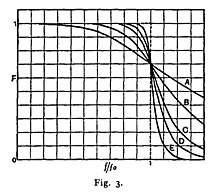
Back مرشح باتروورث Arabic Filtre de Butterworth Catalan Butterworthův filtr Czech Butterworth-Filter German Filtrilo de Butterworth Esperanto Filtro de Butterworth Spanish Butterworthi filter Estonian Butterworth iragazki Basque Filtre de Butterworth French Filtro Butterworth Italian
| Linear analog electronic filters |
|---|

The Butterworth filter is a type of signal processing filter designed to have a frequency response that is as flat as possible in the passband. It is also referred to as a maximally flat magnitude filter. It was first described in 1930 by the British engineer and physicist Stephen Butterworth in his paper entitled "On the Theory of Filter Amplifiers".[1]